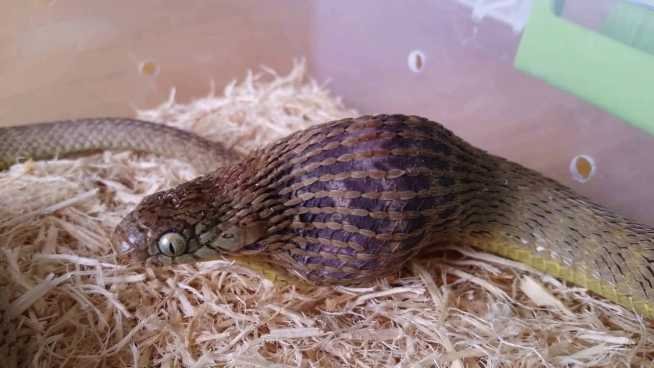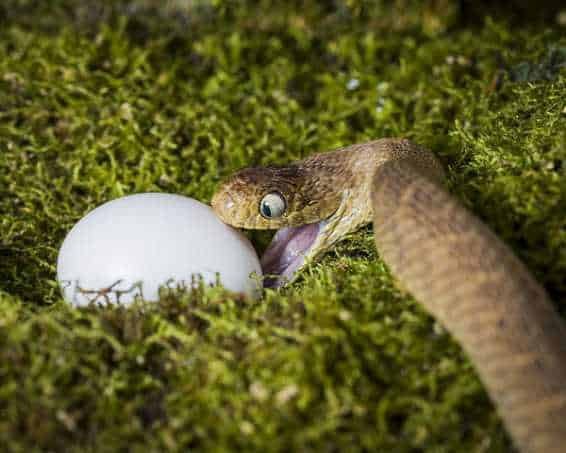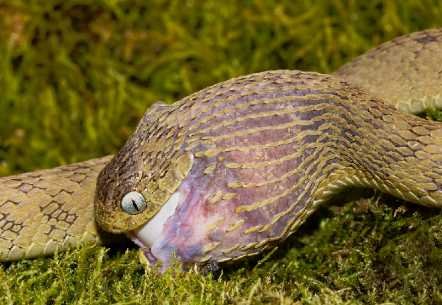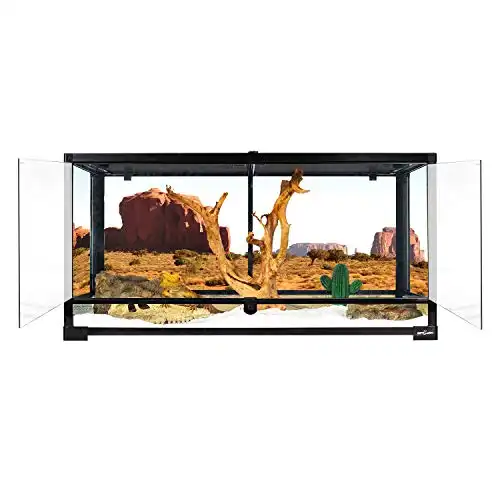
However, the African egg-eater and the Indian egg-eater snake species only eat eggs.
If you don’t like the idea of feeding rodents to snakes, the egg-eating snake may be the pet for you.
They are not as easy to find as some other snakes, but they are quite easy to care for,
That said, they are not the easiest, mainly because it’s not always easy to find the eggs you need. If you’re looking for the easiest snakes to keep, you’ll want one of these docile snakes.
But if you like the idea of an egg-eating snake, they’re not that much more difficult to care for. You just need to know what they like and need to survive.
So let’s find out exactly how to care for a pet egg-eater snake.
Table of Contents
Egg Eater Snake Care
African egg-eating snakes are not bred in captivity. The only place to acquire one is from an exotic pet dealer. You want to make sure your snake is healthy. It’s a good idea to take your snake to a veterinarian who specializes in exotic animals for a check-up.
How to House Your Snake
Before you get your pet snake, make sure you have a proper home for it. This Repti Zoo Terrarium will do the trick.
The males are smaller than the females, so take that into account when choosing your enclosure.
Females are easier to feed because of their size. Fully grown, they are between 24 and 30 inches long.
An important thing to take into consideration when setting up your enclosure is where they live in the wild. Egg-eater snakes live in a dry climate, so you do not want to set up a tropical enclosure.
They also live in trees, because that is the easiest way for them to get the eggs they eat. Giving them something tree-like, like these natural driftwood branches, can help them feel more comfortable.
These snakes don’t hide underground. About an inch of a substrate will be enough bedding for the bottom of your enclosure.
You should set up the enclosure to where one side is heated and one side is room temperature. They also need something they can hide in.
Make Sure Your Enclosure Is Big Enough

Make sure your enclosure is big enough to provide space for the snake, two hiding places, a small bowl of water, and branches for them to climb on. Some people use plastic enclosures with holes in them and a top that comes off, while others use fish tanks.
The best option are enclosures specifically designed for reptiles. Depending on your budget and your preference, you can make the enclosure as simple or as elaborate as you like. As long as the snake has what it needs, the rest is all personal preference.
How To Care For Your Snake
Egg-eater snakes are only active at night, so they will hide most of the day. That’s why it is so important that they have two hiding places to feel safe.
One of the hiding places should be on the warm end of the enclosure. The other one should be on the cool end. Snakes are cold-blooded, so they regulate their body temperature using their environment. It is very important that their environment is as close as possible to how they live in the wild.
They are not “soakers,” so a fairly small bowl of water for drinking is enough. They also need things to climb on. You want your snake to be content in its environment. Make sure you have tree branches and leaves, so they feel like they’re climbing a tree.
Sometimes you have to think like a snake. Think about what your snake would need to survive in the wild, and try to mimic that in your enclosure.
One thing I do not recommend is I do not recommend is getting tree branches from your local forest, because they can have parasites on them. You can purchase parasite-free tree branches or driftwood from your local pet store and from numerous places online.
You can use plastic plant material, like ivy vines for example, for the leaves. These are readily available at your local craft store. If you don’t live near a craft store, these can be found online also.
What To Feed Your Snake
As egg-eater snakes, you feed them eggs. This makes them the closest a snake can get to being vegetarian.
What type depends on the size of your snake. They never get big enough to eat chicken eggs, but the females grow big enough to eat quail eggs. If you get a male or a young female, you may have to feed it finch eggs at first.

As the snake grows, you may have to feed it button quail eggs for a while. Button quail eggs are smaller than spotted quail eggs, but spotted quail eggs are easier to buy. Finding a regular source of food for your snake is going to be the biggest challenge in taking care of it.
Quail eggs can be found at specialty markets if you happen to live near one. You can also purchase quail eggs online. Make sure you do not get fertilized eggs. The egg-eater snake will only eat unfertilized eggs. They are very sensitive to this and always know if there is an embryo inside.
Acquiring finch eggs is more difficult. You may have to go to a pet store that sells finches and ask them what they do with their eggs. If they just throw them away, they may be willing to give them to you.
Another option to consider if you need finch eggs on a regular basis is to raise your own finches. This is not one of the more popular options. It could be a viable option if you have the space, and you like birds.
If you go with this option, make sure you take the eggs out of the nest as soon as the bird lays them. You don’t want an embryo to start growing. Wherever you source your eggs, keep them refrigerated until it’s time to feed your snake.
How Often Should You Feed Your Snake?
Unlike traditional house pets, snakes generally don’t eat as often. An egg-eater snake eats about once a month.

In the wild, they go long periods of time without eating, because birds don’t lay eggs all year round. You may find that your snake is not eating that often, but that doesn’t mean it is sick. That said, if you notice your snake starting to lose weight, then it is time to take it to the vet.
Freshly-caught snakes may not eat at all. They may have to be force-fed until they are comfortable in their environment.
If small eggs are not available, and your snake is not big enough for quail eggs, you may need to resort to force-feeding as well. Do not try to do this on your own. Get advice from your local vet who specializes in reptile care.
You want your snake to stay healthy and live as long as possible. When properly cared for, an egg-eater snake can live up to 10 years or longer.
Once it learns how to eat eggs on its own, it is fairly easy to feed your snake. One way to teach your snake to eat the quail or finch eggs you give it is to make them smell like a bird’s nest.
How do you do this?
If you have pet birds it’s easy. You just rub the egg on the bird’s nest to get the scent. Another way is to rub it with the yolk of a chicken egg.
An important thing to keep in mind is your snake doesn’t swallow eggshells. It splits the shell with strong spinal bones in its gullet, sucks out the inside, and it spits out the shell. Expect to find eggshells on the floor of your enclosure after your snake eats.
Where To Put The Eggs
Some people place the eggs around the cage. Others keep them clutched together in a dish or a makeshift bird’s nest.
If you are really creative, you can make a bird’s nest similar to what they encounter in the wild. You can place it in your branches and put your eggs in there.
This will appeal to your snake’s instinctive nature of climbing trees to get eggs from a nest. If you use this method, securely attach the nest to the branches, so it doesn’t fall out.
As you get to know your snake and its preferences, you will figure out what works best.
How To Handle Your Snake
Your egg-eater snake does not have teeth, so you don’t have to worry about it biting you. Egg-eater snakes have a reputation for being quite docile. Until your snake gets used to you, it may sound like it is hissing.
What it is actually doing is rubbing scales together to create a hissing sound. That’s the egg-eater’s natural defense. They are not constrictor snakes, so you don’t have to worry about your snake squeezing you in any way that could be painful.
They are natural tree climbers, so they will climb on your arm and wrap themselves around your hand when handling them. Be patient with your new snake. It will take time for it to get used to you and allow you to handle it without feeling nervous.
Once you pass this initiation phase, your snake should be easy to handle. Play with your snake on a daily basis, so it stays accustomed to being held by you. If you don’t handle your snake enough, it may revert to being nervous when you try to touch it.
Always remember to be gentle with your snake. These snakes are slender and cannot defend themselves by biting. A very gentle approach in getting your snake used to you will prevent injury to your snake.
Egg-Eater Snake Care: Final Thoughts
The African egg-eater snake makes a very good pet for snake lovers. It is docile and doesn’t have teeth to bite you. Once it gets used to you, it is easy to handle.
Creating housing for your egg-eater snake varies, depending on your style and budget. You may prefer a simple housing enclosure or something more elaborate.
The most difficult part of caring for an African egg-eater is locating a reliable source of food. Once you do, then you should have a long and satisfying relationship with your new pet.
Here are 15 facts about egg-eater snakes you probably don’t know.



I just received 2 Egyptian egg eaters and the smaller Male is not eating the quail eggs, do have any idea where I can order the smaller finch eggs online?
No, I don’t. They can be hard to track down. You’ll probably have to call a few places until you find someone who can help.
Where did you get your Egpytians? I have a female and am looking for a male, but they’re not common at all!
Some of your information is incorrect. Both my female egg eaters (daisypeltis gansi) can take chicken eggs.
My snake stopped eating , she’d it’s skin, and still hasn’t restarted eating over 6 months later
Any advice?